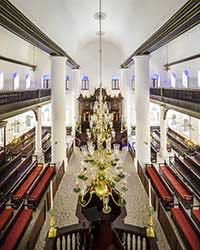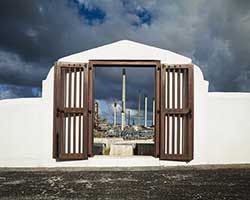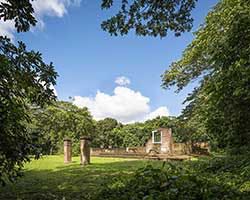A Gallery of faith
17/04/17 20:58 Filed in: Review

A historic Torah scroll on the Tebah at the Bereka ve Shalom ve Gemilut Hasadim Synagogue in St Thomas. Photograph by Wyatt Gallery. Click on any photo in the text to enlarge.
Originally published in the Trinidad Guardian on April 18, 2017
Wyatt Gallery spent eight years working on his new book, Jewish Treasures of the Caribbean, working most of the photography into microthin slots between assignments to the region.
It's tempting to see the book in the context of his more recent works, books collecting photographs chronicling destruction by natural disaster, most notably in Sri Lanka, New Orleans and Haiti.
Many of the sites of Jewish faith in the Caribbean reflect the crumbling state of the faith in the region, with synagogues faltering on the edge of ruin or in an state of collapse, the result of dwindling congregations as the Jewish faithful move on from once prosperous regions that flourished through trade.
Some of the sites are nothing more than piles of rubble and overgrown cemeteries, some of which the photographer arranged to have cleaned for the purposes of recording the hidden Jewish presence.
But this is no lament for disappearing Jews in the Caribbean, though his images of ruined spaces are filled with a bittersweet pathos.
The book may have been arranged around a chronological order for the sites that places them in order of establishment, but that also puts the amazing Mikvé Israel-Emanuel Synagogue on Willemstad, Curaçao not just at the front of the book, opening the collection with a note of distinct triumph as well as a hopeful note of determination, but also on the cover, represented by a stunning worship hall that's all polished wood, gleaming brass fixtures and sandy floor.
The worship site occupies eight pages, the first of the books collection and many of them commanding spreads and the treatment anchors the structure in a continuity of faith that's testament to the creation and use of a building constructed in 1732.
It's followed soon afterward by the Beth Haim Blenheim cemetery in the same country, the Mikvé Israel-Emanuel Synagogue is the first synagogue built in the new world, predating any construction in the Americas by many years, and this cemetery is the first established for Jews, but the resting place is troubled in Gallery's photographs, a site with green shoots sprouting between the massive concrete slabs marking resting places and overseen in the near distance by a massive and unsightly oil refinery belching dark smoke into a rosy sunset sky.
This tension runs throughout the book. The joy of discovery in finding well-preserved artifacts and the clear disappointment in clearing ruins to create photographs for the record.
There may be no sadder photograph in the book than the sight of the Jodensavanne Synagogue in Suriname, once the worship centre of a flourishing (and slave-owning) community established in 1635 and now a collection of crumbling walls with a single window and mossy steps leading nowhere, framed by verdant forest reaching in with green, leafy fingers to reclaim its space.
The Nidhe Israel Synagogue in downtown Barbados is a restored artifact of the Jewish presence in that island and while functional as a house of worship, is largely a tourist attraction, surviving largely on that strength.
Kingston, Jamaica is home to the Shaare Shalom Synagogue, the last remaining worship space, though Gallery investigates many cemetery sites across the island, their abundant presence a testament to the once thriving Jewish community.
The latter third of the book, documenting ruins and cemetery sites in Nevis, St Eustatius, St Maarten, St Thomas and St Croix are rough going, though there is a delightful coda near the end of the book in the Bereka ve Shalom ve Gemilut Hasadim Synagogue in St Thomas, a small practicing space of worship built in 1833.
There is a pervasive sense of the photographer's struggle to wring a commanding visual presence from overgrown cemeteries and badly deteriorated ephemera relevant to the Jewish faith.
These are beautiful photographs of ghosts; sites that have long lost any overt link to Judaism.
Gallery investigated the Jewish presence in Trinidad and Tobago, but found the visuals inadequate for inclusion in the book.
So much of the book finds the photographer torn between photographs of record and aesthetic depictions that work to express his feelings on confronting the Jewish legacy.
The photographs that prove most successful are those which are both ruthlessly historical yet full of a searching yearning.
The photographer's experience

I encountered Wyatt Gallery's work in the late 1990's when MEP Publishers asked me to scan a collection of 8 x 10 inch photos of his work on sacred sites in the Caribbean for a story in Beat. The photographer has never left T&T for long since then.
Over the years, our encounters have been tangential. A phone call here, an introduction to a future assistant there.
His best work has always proceeded uphill, large view cameras, difficult locations, odd hours and in more recent years, in dangerous, post-disaster locations.
Both his artist-driven examination of sacred sites and the empathy that takes him into destruction have informed this recent work while pointing to different directions in the future.
Jewish Treasures of the Caribbean owes a debt to his previous bodies of work, but it is its own, deeply personal meditation on faith and history.
Wyatt Gallery answered some questions about his approach to the book.
ML: You worked with DSLRs for the book project. What drove that decision?
WG: Finances and ease of getting it done. In the past I shot with all 4x5 and 6x7 negative film, which I prefer over digital. But when traveling a lot it's definitely easier to shoot digital. I also couldn't afford a medium format digital back. So DSLR was the best I had access to.
ML: Did you choose a particular camera as the best option for the kind of work you would be doing or was it a matter of just using the camera that you were traveling with?
WG: At the time, only Canon had Tilt Shift lenses for architecture. So that's why I chose Canon many years ago. I buy the highest megapixel option available.
ML: Did you find using digital more restricting for the project?
WG: Personally, I don't like the 6x9 ratio frame compared to the 4x5 ratio. So I shoot everything composed to the 4x5 and then crop it later. Also, when photographing these interiors, it's much darker inside than outside. So I have to bracket the exposures and merge 5 exposures together to get detail in the windows and the shadows. I also like to print my images very large, and the DSLRs still can't print very large and maintain perfect resolution. Film is still much better, in my opinion, for printing large images.
ML: Were there sites that you simply couldn't get to as part of another assignment and which you had to commit to as an investment in completing the project?
WG: All sites I had to return to an photograph again after the original "stumbling upon them" photographs. I had to raise money and ask for support from the Tourist Boards in order to travel to all these places. The local Jewish communities helped me too.
ML: Did working digitally affect how you worked in producing the project?
WG: Working with digital definitely makes it easier in producing the final images! Film is amazing, but then it would cost so much more money to develop the negs, print contact sheets, scan the finals, retouch the finals.
ML: Can you describe your feelings about your religion after confronting this extensive and largely forgotten history of it?
WG: I have more respect for the Jewish people, as a group of people, after learning this history. Many of them stuck to their convictions to have religious freedom, so much so that they traveled across the world to unknown territories, by boat! They continuously fought to have equal rights and justice; something Jews did not have back then.
At the same time, it's challenging that the reason Jews were able to sustain themselves in the Americas was through being involved in the sugar industry and even owning a major plantation in Suriname that owned over a thousand enslaved people.
ML: At what point did you decide…enough? This is a book.
WG: I always was photographing these sites with a book in mind. But the moment I felt complete was when I had finally visited every site that I knew of and that other scholars told me about. Of course, after that, they discovered another small cemetery (maybe 5 graves) in Jamaica. I decided I had to push forward to continue designing the book and get it done. I couldn't keep photographing any updates, or I'd never stop. Hopefully, one day my book will be outdated because of the improvements made to the forgotten Jewish cemeteries.
ML: Were there challenges moving the book into publication because of its subject matter?
WG: Yes, I had about 8 publishers tell me they loved the work but either wouldn't publish it because they didn't think there as enough interest or that they wanted me to pay for the production costs of $25,000US.
blog comments powered by Disqus


